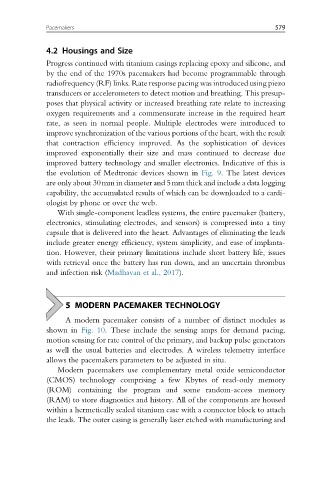Page 587 - Handbook of Biomechatronics
P. 587
Pacemakers 579
4.2 Housings and Size
Progress continued with titanium casings replacing epoxy and silicone, and
by the end of the 1970s pacemakers had become programmable through
radiofrequency (RF) links. Rate response pacing was introduced using piezo
transducers or accelerometers to detect motion and breathing. This presup-
poses that physical activity or increased breathing rate relate to increasing
oxygen requirements and a commensurate increase in the required heart
rate, as seen in normal people. Multiple electrodes were introduced to
improve synchronization of the various portions of the heart, with the result
that contraction efficiency improved. As the sophistication of devices
improved exponentially their size and mass continued to decrease due
improved battery technology and smaller electronics. Indicative of this is
the evolution of Medtronic devices shown in Fig. 9. The latest devices
are only about 30mm in diameter and 5mm thick and include a data logging
capability, the accumulated results of which can be downloaded to a cardi-
ologist by phone or over the web.
With single-component leadless systems, the entire pacemaker (battery,
electronics, stimulating electrodes, and sensors) is compressed into a tiny
capsule that is delivered into the heart. Advantages of eliminating the leads
include greater energy efficiency, system simplicity, and ease of implanta-
tion. However, their primary limitations include short battery life, issues
with retrieval once the battery has run down, and an uncertain thrombus
and infection risk (Madhavan et al., 2017).
5 MODERN PACEMAKER TECHNOLOGY
A modern pacemaker consists of a number of distinct modules as
shown in Fig. 10. These include the sensing amps for demand pacing,
motion sensing for rate control of the primary, and backup pulse generators
as well the usual batteries and electrodes. A wireless telemetry interface
allows the pacemakers parameters to be adjusted in situ.
Modern pacemakers use complementary metal oxide semiconductor
(CMOS) technology comprising a few Kbytes of read-only memory
(ROM) containing the program and some random-access memory
(RAM) to store diagnostics and history. All of the components are housed
within a hermetically sealed titanium case with a connector block to attach
the leads. The outer casing is generally laser etched with manufacturing and

